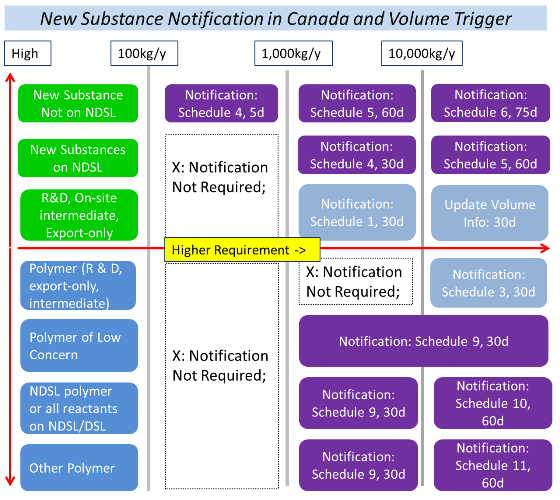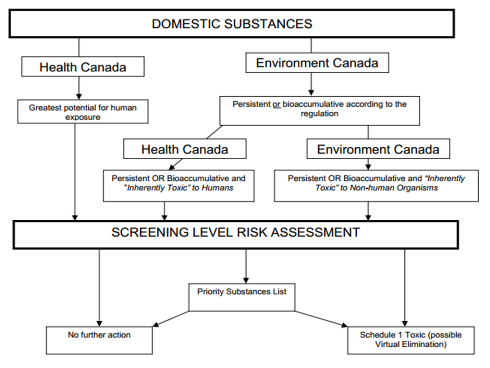Canadian Environmental Protection Act (CEPA)
Little Pro on 2015-12-31
The Canadian Environmental Protection Act 1999 (CEPA 1999) is the most important chemical control law in Canada. It is a broad act covering a number of subjects, i.e., chemicals, living organisms, marine environment, vehicles, and hazardous wastes. In this article, we will only talk about how it manages new chemical substances and existing chemicals in Canada.
New Substances Management
Substances that are not on the Domestic Substances List (DSL) are considered to be new chemical substances in Canada. Any company or individual who plans to import or manufacture a new substance must provide Environment Canada with a New Substances Notification (NSN) dossier to import or manufacture. Substances that are not on the DSL but are listed on the Non-Domestic Substance List (NDSL) are subject to new substance notification with reduced requirements.
The type of information required and the timing of the notification will depend on such factors as the type of substance (chemical substance, polymer or bio-chemical), the quantity of the substance, the intended use of the substance and the circumstances associated with its introduction.
The risks of substances determined to be or suspected of being toxic or capable of becoming toxic may be managed, as necessary, through conditions or prohibitions imposed on their import or manufacture.
New Substance Notification Exemptions and Requirements
Articles, impurities, by-products, naturally occurring substances and chemical substances regulated by other Canadian laws are exempt from the new substance notification requirements. For a mixture, the notification requirement only applies to individual substances in it.
New substances in small volumes do not require notification unless they reach the volume triggers specified by the CEPA. Compared to regular new substances, new substances on the DSL and polymers are subject to reduced information requirements. The review time needed is also shorter.
The picture below shows the volume trigger for different types of new substances and required information:

Detailed information required for each notification schedule can be found here.
Existing Substances Management
CEPA 1999 includes specific requirements for the assessment and management of substances currently existing in commerce or being released to the environment in Canada. The Minister of the Environment and the Minister of Health jointly assess existing substances. The picture bellow shows how it works (source: Environment Canada).

The risks of priority existing substances are controlled by various regulatory lists:
- Significant New Activity;
- Priority Substances List;
- Toxic Substances List;
- Virtual Elimination List;
- Export Control List;
Significant New Activity
Significant new activities can apply to existing substances on the Domestic Substances List or to new substances. A significant new activity is an alternative use of a substance or other activity that results or may result in:
- a significantly greater quantity or concentration of the substance in the environment; or
- a significantly different manner or circumstances of exposure to the substance.
If there is a suspicion that a significant new activity may result in the substance becoming toxic, the substance can be subject to a Significant New Activity Notice. The Notice communicates the criteria under which the government must be re-notified. The government assesses the new information on the substance to determine if it is toxic in relation to the significant new activity.
View the List of Substances Subject to Significant New Activity Notice
Priority Substances List
The Canadian Environmental Protection Act, 1999 (CEPA 1999, section 76) requires the Ministers of the Environment and of Health to establish a Priority Substances List (PSL) that identifies substances to be assessed on a priority basis to determine whether they are toxic. A Priority Substance may be a chemical, a group or class of chemicals, effluents or wastes.
Currently there are 69 substances on the Priority Substances List (updated in Jan 2015). Examples: 1,1,1-Trichloroethane, Styrene, Benzene, and Formaldehyde
Download the Latest Priority Substances List
Toxic Substance List
CEPA 1999 requires that substances on the PSL be assessed within 5 years of their addition to the List. Environment Canada and Health Canada have a legal obligation to determine if these PSL substances are "toxic".
A substance is toxic if it is entering or may enter the environment in a quantity or concentration or under conditions that:
- have or may have an immediate or long-term harmful effect on the environment or its biological diversity;
- constitute or may constitute a danger to the environment on which life depends; or
- constitute or may constitute a danger in Canada to human life or health.
Preventive or control actions such as regulations, guidelines or codes of practice, are then considered for any aspect of the substance's life cycle from the research and development stage through manufacture, use, storage, transport and ultimate disposal or recycling.
Furthermore, substances determined to be "toxic", persistent, bio-accumulative, anthropogenic, and which are not naturally occurring substances shall be proposed for implementation of virtual elimination.
Examples: asbestos, lead, mercury and its compounds, Trichloroethylene
Download the Latest Toxic Substances List
Virtual Elimination List
Substances on this elimination list are virtually prohibited. CEPA may specify a quantity limit or concentration limit. There are only two entries on this list for the moment: Hexachlorobutadiene (HCBD), Perfluorooctane Sulfonate and Its Salts(updated in Jan 2015).
Export Control List
This Export Control List contains substances whose export is controlled because their manufacture, import and/or use in Canada is prohibited or severely restricted, or because Canada has accepted, through an international agreement, to control their export.
This list can be divided into 3 parts:
- Part 1 - Prohibited Substances (i.e., Endrin);
- Part 2 - Substances Subject to Notification or Consent(i.e., Mercury compounds, Ethylene oxide, PFOS);
- Part 3: Restricted Substances (i.e., Carbon tetrachloride)
Download the Latest Export Control List
Reference & Resources
Click here to access all references and resources for Canada including regulations, regulatory lists and useful links to the websites of competent authorities.
Having Questions?
We do not provide consultancy services. If you have questions or need any help, please contact our sponsor. You may also find an expert in CSP business directory below. If you are a consultant, you may get yourself listed in CSP business directory (free) or sponsor this page to leave your contact info on this page..

Tags: Topics - Canada, REACH-like Regulation and Registration